The Controlled-Pattern Offset Bipole Loudspeaker
Much of the difference between the concert hall and the listening room lies in the reverberant field. In the concert hall, there is a fairly long time delay between the first-arrival sound and the arrival of significant reverberant energy – and once that reverberant energy begins to arrive, it is powerful and rich and diffuse, and its spectral balance is similar to that of the first-arrival sound. Finally, it decays rather slowly. This well-energized, long-lasting reverberant field gives live music that delicious aliveness and lushness that thrills and envelopes us.
In contrast, in a typical home listening room, the first reflections begin to arrive after only a fairly short time delay, and those early reflections tend to be detrimental. The relative amount of energy in the reverberant field is much less than in the concert hall, the spectral balance is usually wrong (being dominated by the speaker’s omnidirectional output, which is seldom smooth), and the reverberant field dies away fairly quickly.
The controlled-pattern offset bipole loudspeaker is an attempt to put more energy out into the reverberant field in a way that is beneficial rather than detrimental.
For the purposes of this discussion, we will define “early-onset” reflections as those arriving within 10 milliseconds of the first-arrival sound, and “late-onset” reflections as those arriving after the first 10 milliseconds. While the direction that the reflections come from also matters, in general early-onset reflections are undesirable and late-onset reflections are desirable, but both are subjectively improved if they are spectrally similar to the first-arrival sound.
Advantages and Disadvantages
The controlled-pattern offset bipole loudspeaker, when set up properly, offers benefits in these areas:
- Reduced coloration from early-onset reflections. This is for two reasons: they are reduced in magnitude, and they do not significantly skew the spectral balance.
- Twice as much desirable, spectrally-correct late-onset reverberant energy, compared to a comparable monopole, with no increase in early-onset reverberant energy
- A wide sweet spot with consistent tonal balance throughout the room
- No baffle-step falloff in the lower midrange region
- Smoother and usually more extended in-room bass than a comparable monopole
Its disadvantages include:
- Twice as many drivers are needed, thus halving the per-driver budget compared to an equal-cost monopole
- Wide enclosures are required
- Placement close to the wall behind the speakers is usually detrimental; the minimum recommended distance is 3.5 feet.
Background
Attempting to more closely approximate the reverberant field of a live venue is nothing new – quasi-omnidirectional speakers have been around for a long time and have enjoyed varying degrees of success. Quite a few well-received “conventional” designs have incorporated a rear-firing tweeter. Dipole loudspeakers inherently have desirable radiation characteristics when positioned several feet out into the room; this positioning imposes a significant, beneficial time-delay on the backwave energy, whose spectrally-correct contribution thus becomes part of the late-onset reverberant energy.
Conceptually, the controlled-pattern offset bipole resembles a dipole at midrange and treble frequencies, and resembles a monopole at low frequencies, while offering some room-interaction improvements over a traditional monopole, particularly in the midrange and bass regions.
Implementation
The controlled-pattern offset bipole loudspeaker is depicted in Figures 1 and 2. The rear of the speaker duplicates the drivers on the front of the speaker, but offset vertically, with the rear drivers – in particular the woofer – being closer to the floor than the front drivers. This is key to the improved room-interaction of the design in the bass and midrange regions.
The “controlled pattern” aspect calls for a constant directivity horn or waveguide to be crossed over to a fairly large-diameter mid-woofer at the frequency where the woofer’s radiation pattern has narrowed to match the horn’s. As a result the reverberant energy filling the room will have a similar spectral balance to the first-arrival sound. Since the reverberant energy is a strong contributor to perceived timbre, the timbre inherent on the recording (and in the clean first-arrival sound) is preserved. In addition, the tonal balance holds up very well throughout the room – just like with live instruments.
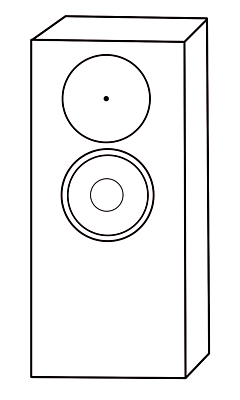
Figure 1. Controlled-pattern offset bipole speaker, front view.
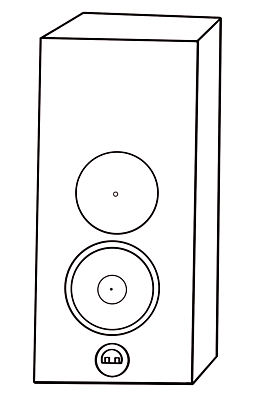
Figure 2. Controlled-pattern offset bipole speaker, rear view.
This well-controlled radiation pattern allows us to beneficially aim the speaker’s output. Figure 3 shows the radiation pattern of a 90-degree pattern offset bipole, toed-in at 45 degrees. With the speaker closer to the sidewall than to the wall behind it, the only strong front-hemisphere early reflection in the horizontal plane is off the opposite side wall (the other early horizontal reflections are weak, as they are generated by energy falling outside the primary 90 degree angle, or they come from behind the listener). Because of the way the ear/brain system processes reflections, that early reflection coming from the opposite sidewall is interpreted as spaciousness rather than coloration. With this configuration, most of the first multiple-bounce reflections from the rear-facing array will also arrive from the sides, which is desirable.
Aside from early same-side reflections, reverberant energy that arrives from the side walls is the most beneficial in terms of spaciousness and a sense of envelopment. By eliminating the need to treat those same-side first reflection zones, the toed-in controlled pattern makes it more practical to preserve the energy that will arrive in beneficial lateral reflections. In general the less absorption we need to use in the room the better; just as a live piano or acoustic guitar sounds best in a fairly lively room, so too will a loudspeaker system that generates a spectrally-correct reverberant field.
This 45-degree toe-in angle, with axes criss-crossing in front of the listening position, also gives significantly improved imaging for off-centerline listeners. The ear localizes sound images by two mechanisms: arrival time and intensity. For the off-centerline listener listening to conventional loudspeakers, the near speaker “wins” both arrival time and intensity, and as a result the center image moves over to the near speaker. With an appropriate controlled-pattern speaker set up correctly, the near speaker wins arrival time but the far speaker wins intensity because the off-center listener is off-axis of the near speaker but on-axis of the far speaker. The key is for the near speaker’s off-axis output to roll off fairly rapidly and smoothly; because of this requirement, this setup doesn’t work well with most speakers. See Figure 4.
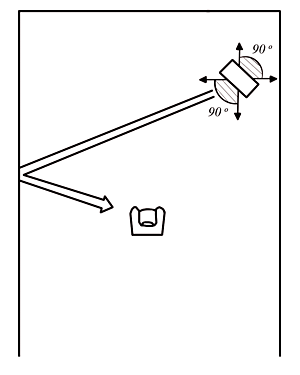
Figure 3. Radiation pattern of a single toed-in controlled-pattern offset bipole loudspeaker, showing geometry of first sidewall reflection. With this setup geometry, that is the only strong early reflection in the horizontal plane other than reflections off the wall behind the listener.
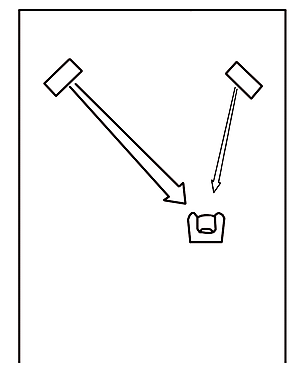
Figure 4. The off-center listener is on-axis of the far speaker but well off-axis of the near one, so the far speaker is louder in the mids and highs. The key element here is smooth, fairly rapid roll-off of the near speaker’s off-axis response.
Bass effects
In my opinion the ideal bass system would use multiple subwoofers distributed asymmetrically around the room (credit to Earl Geddes), the idea being that woofers in dissimilar locations will produce dissimilar in-room response curves, and the sum of these dissimilar in-room responses is smoother than any one of them alone would have been.
When you toe-in a controlled-pattern offset bipole, the two woofers will be a different distance from each of the room boundaries in all three dimensions. While not as ideal as spreading them far apart, the result is still a worthwhile smoothing of the in-room bass.
Taming early reflections
The idea of mitigating the detrimental effects of early reflections by adding rear-firing drivers seems counter-intuitive, but that is indeed one of the benefits of the controlled-pattern offset bipole.
Graph 1 is the simulated frequency response of an 8″ woofer mounted on a hypothetical infinite baffle. What you see is the on-axis response and the power response. The two diverge at higher frequencies due to beaming.
Now let’s put that 8″ woofer in a speaker cabinet, measuring 42″ tall by 10″ wide by 14″ deep, with the woofer’s center 25″ above the floor. Let’s place this speaker 3.5 feet out from the wall behind it (distance measured to back of speaker cabinet), and look at the net effect of the floor bounce, front wall bounce, and baffle step (we’re leaving out the side walls, ceiling, and wall behind the listener for the sake of clarity, but you’ll get the general idea anyway). Graph 2 is the simulated response with the speaker in this location.
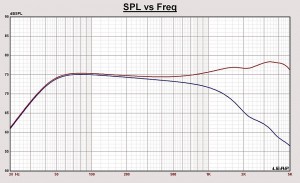
Graph 1. Simulated infinite baffle response, 8" woofer. Top curve = on-axis response; bottom curve = sound power response. (Click for larger.)
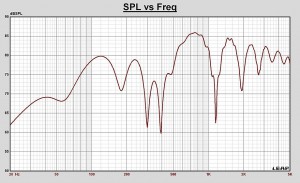
Graph 2. Monopole 8", simulated on-axis in-room response, quarter-space (floor + front wall). Includes baffle step, floor bounce, and front wall bounce. Box is 42" tall by 10" wide by 14" deep, rear of speaker is 42" out from front wall. (Click for larger.)
Whoa – that looks terrible! Yes, it does, but it’s educational. Before we proceed, note that the ear tends to average-out the sound across intervals roughly 1/3 octave wide, so narrow-band peaks and dips are ignored by the ear while a broad peak or dip will be audible (peaks are worse than dips). Broad trends, like the response sloping gently up or down, are quite audible.
Here, we can see a series of peaks and dips (comb filtering) from the floor bounce. The baffle step kicks in at about 670 Hz, below which the average response is clearly a bit lower in level. The irregular dip between 260 Hz and 500 Hz is associated with the floor-bounce cancellation dip, mitigated a bit by what’s probably a bounce off the rear wall. If you consider that the baffle step by itself imposes only a 3 dB per octave roll-off below 670 Hz, you can see that this dip’s contribution is actually pretty substantial.
Now let’s try a bipole, but for the sake of illustration let’s not do it right. Let’s add a second woofer at the same height as the first one, and double the cabinet depth to obtain sufficient internal volume. We’ll keep the rear baffle 3.5 feet from the wall. You can see the result in Graph 3.
Two things jump out at us: a deep notch at 200 Hz, and a lot of hash higher up. Fortunately, the ear is forgiving of that higher-up hash (it happens all the time in real life), but that notch is kind of scary. This is the wrap-around notch, and it happens at the frequency where the wrap-around path from the rear driver to the listener is half a wavelength longer than the front woofer’s direct path. At that frequency the wrap-around energy arrives 180 degrees out-of-phase with the front wave, and cancellation occurs. Obviously, we’ll have to do something about it.
This non-offset narrow bipole did fill in the floor-bounce dip somewhat, but the floor-bounce peak is still there. While it’s not obvious that we mitigated the baffle step, actually we did a bit – but because the front of the box is closer to the microphone than in Graph 2, it’s not apparent in our simulated measurement. Finally, we helped things out below 100 Hz; compare the slopes from 100 Hz down to 20 Hz in Graph 2 and Graph 3. The wrap-around energy is in-phase in the low bass region and is therefore providing reinforcement. Still, overall it’s hard to say that we made a worthwhile improvement.
Note that commercial bipolar speakers have used a variety of techniques to deal with the wrap-around notch, a survey of which is beyond the scope of this article. I don’t want to leave you with the impression that other designers somehow overlooked it, but I wanted to let you see that it’s a real issue.
Okay, now let’s do it right. Let’s make the baffle wider than it is deep, and let’s move that rear-firing woofer down near the floor (as shown in Figure 2). The result can be seen in Graph 4.
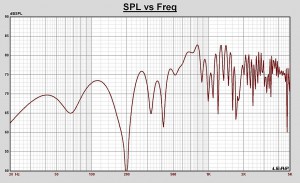
Graph 3. Non-offset narrow-baffle bipole 8", simulated on-axis in-room response, quarter-space (floor + front wall). Includes baffle step, floor bounce, front wall bounce, and wrap-around. Box is 42" tall by 10" wide by 28" deep, rear of speaker is 42" out from front wall. (Click for larger.)
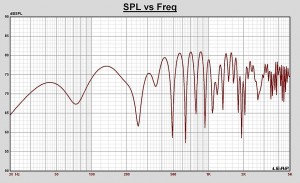
Graph 4. Controlled-pattern offset bipole 8", simulated on-axis in-room response, quarter-space (floor + front wall). Includes baffle step, floor bounce, front wall bounce, and wrap-around. Box is 42" tall by 20" wide by 14" deep, rear of speaker is 42" out from front wall. (Click for larger.)
We can still see the remnants of the wrap-around, but it’s pretty benign now, and less than one-third of an octave wide. We still have harmless hash higher up, but the floor-bounce dip is gone and so is all but the faintest hint of the floor bounce peak and the baffle step. Once again, our low bass holds up a lot better than with the monopole configuration. Look back at Graph 1, and you’ll see that if you mentally average out the response in Graph 4, it comes reasonably close to the ideal infinite baffle case.
Now compare Graph 2 (the monopole) with Graph 4 (the controlled-pattern offset bipole). There you have it! You wouldn’t have believed it a few minutes ago, but we have very significantly reduced the detrimental effects of early in-room reflections by judiciously adding rear-firing drivers!
Relevance
Does all this really matter? Are we barking up the right tree here?
Drawing on decades of experience investigating what really matters in loudspeaker design, Dr. Floyd Toole, retired Director of R&D at Harmon International, describes, in his landmark book “Sound Reproduction,” five parameters that are good predictors of subjective preference. They are:
- The first-arrival sound’s frequency response at the listening position;
- The spatially-averaged response across a window plus or minus 30 degrees horizontal and plus or minus 10 degrees vertical;
- The spatially-averaged response of the early reflections from the four walls, ceiling, and floor;
- The sound power, or the sum total of the speaker’s acoustic energy radiation; and
- The directivity index, which looks at the difference between the first-arrival sound’s frequency response and the sound power (summed omnidirectional response).
Most designers try to get the first one of these right. The controlled-pattern offset bipole configuration addresses the other four as well.
For the DIY community
I have little fear that any of my competitors will rush to put their own variations of the controlled-pattern offset bipole into production; we loudspeaker designers are a proud, arrogant bunch. If any do, I’d consider it flattery and would love to hear about it.
Aside from my own commercial efforts, the DIY community is the most likely place for the controlled-pattern offset bipole to rear its wide, shallow head. So, here are my suggestions for DIYers:
- Don’t do it if you can’t position the speakers at least 3.5 feet out in front of the wall behind them (measured to center of rear baffle when toed-in). Closer than that, and in most cases you’d be better served by a monopole. If Maggies won’t work in the location you have in mind, neither will bipoles.
- Going bipolar will not salvage a mediocre design. It can make a good speaker better, but it cannot make a bad speaker good. Crossover design remains the heart and soul of loudspeaker design – get that right first. The controlled-pattern offset bipole configuration is no substitute for otherwise competent design.
- Try to make the box at least 1.5 times wider than it is deep. Even wider/shallower is okay too.
- Keep the rear-facing woofer as close to the floor as is reasonably feasible.
- Be aware of the low-bass boost; if you ignore it, you may well end up with too much bass. The output from the rear woofer adds in semi-random phase well above the wrap-around frequency, but transitions to in-phase in the low bass region. If you’re doing a ported box you’ll probably want to tune lower than normal, and if possible incorporate a means of adjusting the tuning frequency. Taking advantage of this low-bass boost is one of my secret weapons… and now it’s not so secret anymore.
Acknowledgments
The 90-degree front-and-back pattern that I use is a deliberate imitation of Roger West’s classic SoundLab A-1, which was my inspiration, and Dr. West knows that I’m borrowing from his ideas. As for how to go about actually controlling the radiation pattern, I learned that (and a lot more) from Earl Geddes. My sincere thanks to both Roger and Earl.




Professor, I didn’t know you were a professor before reading this, that is a fine read. As you know, I have heard your Planetarium Beta system at one of your customer’s homes in my area. And it was a fabulous session with some my albums and some of his. Unexpectedly, the one that stood out the most to me at the time was Art Blakey and The Jazz Messengers at Keystone 3 (Concord Jazz). I’ve had the pleasure of being in the audience at this club several times back in the day. On your Beta system, it was live as live gets and the detail was phenomenal. Instruments were life size as if you were seated front and center (at the volume we were listening) with space between and around them and the old man was very present behind the front line working the pants off of his young players! What a tour de force the last track is. The audience thought so, too, that was very clear. Yet the system was delicate and appropriately lifelike on a chamber sized group discreetly miked in a large room (pictured in the liner notes) with seemingly perfect placement, ambience and decay. That particular BIS recording I’ve heard many times on my various systems but never as convincingly real.
Your customer is my new new best friend rather he likes it or not. Fortunately for me, he has some excellent recordings, also.
Duke, thanks for telling everyone abut this cool place on Audio Asylum!
Chris (Ka7niq)
Hi Duke,
Yep, this is, indeed, waj4all (a.k.a. Winston A. James, from the Asylum). Seems I’ve finally gotten ’round to leaving a comment here, after all.
And my main comment is that you’re obviously a brave soul to make so many of your trade-secrets available to all and sundry. However, in my opinion, this exposes another facet of the impeccable character others have alluded to, so far as I’ve seen. The willingness to share your ideas for the good of the hobby (even at risk of the possible detriment to the sales of your own products) is an indication of your integrity. and a fact which, I’m sure. will not escape your potential customers. This, combined with the quality of your innovative designs can only ensure continued success for you and your line; AudioKinesis.
Nevertheless, allow me to add my own two-cents worth in wishing you ALL the success you deserve!
Winston.
Hi Duke!
Can you make a simulation when the additional woofer is on the front baffle and close to the floor?
My two cents that this solves the floor bounce too (but not the power response).
Csaba